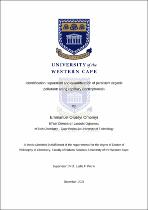| dc.contributor.advisor | Petrik, Leslie F. | |
| dc.contributor.author | Omoniyi, Emmanuel Oluseyi | |
| dc.date.accessioned | 2022-06-30T14:12:45Z | |
| dc.date.issued | 2022 | |
| dc.identifier.uri | http://hdl.handle.net/11394/9143 | |
| dc.description | Philosophiae Doctor - PhD | en_US |
| dc.description.abstract | Water quality deterioration and scarcity can be attributed to natural causes and anthropogenic activities which include climate change and an incessant industrialisation, yet with lack of functional and reliable wastewater treatment facilities. As a consequence of these activities, many chemicals have found their way into water bodies and subsequently compromise the quality of water systems. Among these chemicals are persistent organic pollutants (POPs), including pharmaceuticals, endocrine disrupting compounds (EDCs), etc. In order to separate, identify and quantify persistent and emerging contaminants in the water samples, this study considered the pre-concentration and separation steps followed by quantification using capillary electrophoresis. | en_US |
| dc.language.iso | en | en_US |
| dc.publisher | University of the Western Cape | en_US |
| dc.subject | Organic pollutants | en_US |
| dc.subject | Water quality | en_US |
| dc.subject | Silver nanoparticles | en_US |
| dc.subject | Climate change | en_US |
| dc.subject | Chemistry | en_US |
| dc.title | Identification, separation and quantification of persistent organic pollutants using capillary electrophoresis | en_US |
| dc.rights.holder | University of the Western Cape | en_US |
| dc.description.embargo | 2023 | |

